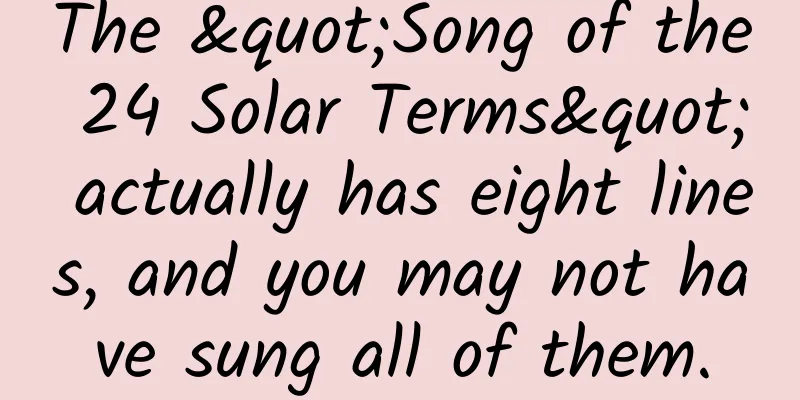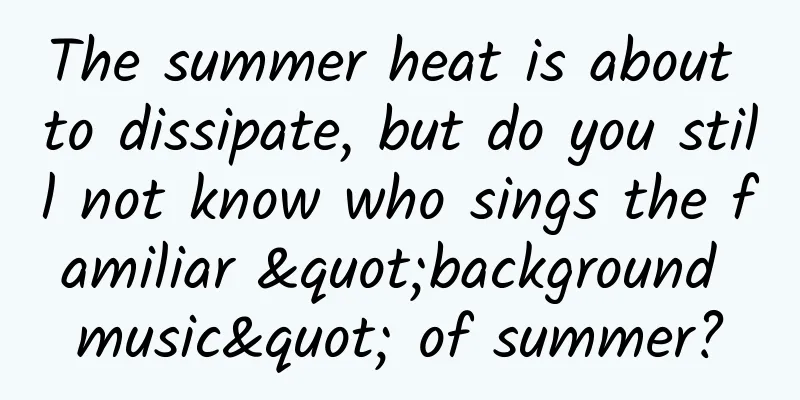The "Song of the 24 Solar Terms" actually has eight lines, and you may not have sung all of them.

|
The beginning of winter has just passed, which means winter has officially begun. (So, the beginning of winter is here, have you put on your long johns?) Image source: veer gallery When talking about the solar terms, we have to mention the solar term song that we learned in elementary school and which our friends are still familiar with today. "Song of the Twenty-Four Solar Terms" in the Primary School Chinese Textbook In just 28 words, it not only records the change of seasons, but also reflects the temperature rise and fall and the rainfall of the year. But what most people don't know is that they only "sang" half of this well-known solar term song. Compared with the catchy first half, the second half of the solar term song is little known. What exactly does the second half of the solar term song say? How did the ancients five thousand years ago accurately determine the 24 solar terms? What other interesting "cold knowledge" are there about the 24 solar terms, which are praised by the international meteorological community as "China's fifth invention"? Don't worry, let us first stand in the perspective of the ancients looking up at the stars, and appreciate the wisdom of our ancestors' induction with the heavens and the earth. The answer lies in it. Part 1 Look up at the stars, keep your feet on the ground It’s not about poetry, but about God’s will Hegel said: "A nation must have some people who look up at the stars, and then there will be hope for the nation". As one of the earliest nations to look up at the stars, the Chinese people began to explore the mysteries of the universe very early, and thus developed a complete and profound stargazing culture. Tracing back to the origin of the 24 solar terms, we can understand the spiritual implications of the simple act of the ancients looking up at the stars. The 24 solar terms were originally formulated based on the position changes of the "handle" of the Big Dipper, that is, during the year, the stars move, the handle points to the east, and it is spring all over the world; the handle points to the south, and it is summer all over the world; the handle points to the west, and it is autumn all over the world; the handle points to the north, and it is winter all over the world". Schematic diagram of the Big Dipper, which are Alkaid, Mizar, Alioth, Megrez, Phecda, Merak and Dubhe. Image source: NASA In addition, the ancients also condensed the natural mysteries they had gained insight into in the calendars passed down from generation to generation. The so-called calendar, in simple terms, is a method of measuring time based on the natural laws of celestial changes. The calendar based on the movement of the moon around the earth is called the lunar calendar; the calendar based on the changes in the position of the sun in different seasons is called the solar calendar. As early as the Western Han Dynasty, the first calendar in my country with complete written records, the Taichu Calendar, set the 24 solar terms as a supplementary calendar. The 24 solar terms originated from the Yellow River Basin, the birthplace of my country's farming culture. Its birth is closely related to my country's farming culture, reflecting the survival wisdom of the ancient Chinese working people in the unpredictable nature of "responding to the destiny of heaven and earth and following the qi of the four seasons." "Qimin Yaoshu" says: "Follow the time of heaven and measure the advantages of the land, then you will use less effort and achieve more success." The "time of heaven" here refers to the activity of the sun, which has an important impact on agricultural production in ancient China. The ancients were able to clearly understand the changing laws of climate throughout the year through the 24 solar terms, so as to grasp farming and arrange farming activities reasonably. For example, during the Qingming Festival, all things are clean, clear and full of vitality, which is a good time for spring ploughing and planting; and Grain in Ear also means "busy planting", referring to the fact that awned crops such as wheat are about to mature, and farmers have to harvest and save seeds and begin their busy field life. The "two equinoxes and two solstices" of the 24 solar terms - the spring equinox, autumnal equinox, summer solstice, and winter solstice - were first measured by the "gnomon" shadow measurement method in the Zhou Dynasty and the Spring and Autumn Period in my country. The world's oldest observatory - the gnomon building is still preserved in Gaocheng Town, Dengfeng County, Henan Province. Since the sun's direct point changes periodically between the Tropic of Cancer and the Tropic of Capricorn throughout the year, the gnomon shadow measurement uses an upright pole to observe the length of its shadow at noon to determine the solar term. When the sun's direct point is on the Tropic of Cancer, the solar altitude angle at noon is the largest and the pole's shadow is the shortest, and this day is designated as the summer solstice; when the sun's direct point is on the Tropic of Capricorn, the solar altitude angle at noon is the smallest and the pole's shadow is the longest, and this day is designated as the winter solstice. The shadows of the spring and autumnal equinoxes are the same length, both of which are half of the sum of the lengths of the shadows at the two solstices. The current 24 solar terms come from the "fixed solar terms method" established more than 300 years ago, which is divided according to the degree of movement of the earth on the ecliptic (the orbit of the earth's revolution around the sun). The earth orbits the sun 360 degrees, and the entire orbit is divided into 24 parts. Each solar term is equivalent to the position of the earth on the ecliptic for every 15 degrees of movement. In a year, there is a 15-day interval between each two solar terms. The 24 solar terms start from the beginning of spring and end at the great cold, and repeat over and over again. According to the current division standard of the 24 solar terms, there will be two solar terms in each month. If the earth is used as a reference, the 24 solar terms reflect the movement of the sun, and the solar calendar (also known as the Gregorian calendar) is a calendar formulated based on the changes in the position of the sun, so the dates of the solar terms in the current Gregorian calendar are basically fixed. At this point, I can announce the last four lines of the solar term song to everyone: "The first half of the year comes on the 6th and 21st, and the second half comes on the 8th and 23rd. The dates of the two solar terms are fixed every month, with a maximum difference of one or two days." The last four lines mean that the solar terms in the first half of the year are mostly concentrated around the 6th and 21st of each month, while those in the second half of the year are mostly concentrated around the 8th and 23rd. The dates of the solar terms in the Gregorian calendar are relatively fixed, with a maximum difference of no more than one or two days. The first four lines of the solar term song list the names of these poetic solar terms one by one, and the last four lines clearly and straightforwardly tell the "birthdays" of the solar terms, which are both elegant and popular, and are indeed a clear sound in the spirit of Chinese history and culture. Image source: China Meteorological Administration The 24 solar terms are the ancient people's perception of life, nature, and the stars in the universe. It has a vivid sense of time and space, and has told us the natural order of the changing of the four seasons through thousands of years. Part 2 The Beginning of Autumn is not “autumn” and the White Dew is not “white”. Lesser Cold is stronger than Greater Cold, is there a deviation in the solar terms? With the development of social industrialization and the progress of science and technology, the farming culture of "living by the weather" seems to be getting farther and farther away from us. The song about the solar terms is short and concise. If you only understand its literal meaning, it is often easy to make a fool of yourself. Here, let's share some "little knowledge" about the solar terms. While understanding the fun of it, you can also get a glimpse of the profoundness and moderation of Chinese culture. The Beginning of Autumn is not "Autumn": The Beginning of Autumn has arrived, but it does not mean the end of the hot summer and the arrival of the cool autumn. The autumn that people usually talk about refers to the autumn in the climate season. The division of autumn in the climate season is based on the "average temperature", that is, the average temperature of the local area for 5 consecutive days must drop steadily from above 22℃ to below 22℃ to be considered the real autumn season. my country has a vast territory. Except for the places in the north of my country and the places with higher altitudes, the temperature in most areas is still high at the beginning of autumn, and the south is more likely to face the attack of the "autumn tiger". When the temperature in most parts of the country drops to the standard of autumn, the beginning of autumn has already passed for many days. It is precisely because of the asynchronous "entry into autumn" that the first cup of milk tea in autumn is late. 2020 National Autumn Progress Map Image source: China Weather Network Bailu is not "white": "Reeds are green, Bailu turns to frost, the so-called lover is on the other side of the water." After Bailu, the heat dissipates and the cold rises, so Bailu is a season that indicates the change of cold and heat. In the early morning of autumn, friends who get up early can often see crystal clear dewdrops on flowers, plants and trees. These dewdrops are formed by the condensation of water vapor in the atmosphere at night due to the large temperature difference between day and night. But how can the dewdrops be "white"? In fact, the white of Bailu does not refer to the white in the palette, but the "color matching" given by the ancients to the four seasons and five elements, that is, "Spring Jiayi wood color belongs to green, summer Bingding fire color belongs to red, central Wuji earth color belongs to yellow, autumn Gengxin gold color belongs to white, winter Rengui water color belongs to black". So white is used to describe the dew in autumn, hence the name Bailu. Lesser Cold is stronger than Greater Cold: Greater Cold is the coldest season of the year. However, there is a folk proverb that goes, "Lesser Cold is stronger than Greater Cold, and it is common and not rare." Doesn't this "make a fool" of the song about the solar terms? It is not possible to generalize which solar term is the coldest, Lesser Cold or Greater Cold, but it varies from north to south. For most areas in the north, Lesser Cold is indeed colder than Greater Cold, while for most areas in the south, Greater Cold is the coldest. However, in the Yellow River Basin, where the 24 solar terms originated, Lesser Cold is colder than Greater Cold in most cases. Did the ancients get the order wrong? For this question, the idea of "everything turns to its opposite when it reaches its extreme" in traditional Chinese culture can give an explanation, that is, the rapid return to spring after Greater Cold reflects the phenomenon of extreme cold and warming, so the last solar term of winter is called Greater Cold. Comparison of Minor Cold and Major Cold Temperatures in Some Capital Cities in China Image source: China Weather Network There are deviations in the solar terms: The reason why the 24 solar terms played a very important role in ancient Chinese agricultural activities is that they reflect the climate characteristics that are instructive for production activities. It can be said that our ancestors explored the laws of climate change in nature through "astronomy". But as mentioned above, the birthplace of the solar term song is in the Yellow River Basin, so it "sings" to a large extent the local residents' perception of phenological changes and the agricultural activities that should be carried out at that time. my country has a vast territory, and it is biased to generalize. But the wisdom of the ancients lies in focusing on practice rather than blindly following old rules, and summarizing the agricultural experience related to the solar terms in different regions according to local conditions. For example, the "autumn equinox wheat field" in the Jiangnan Basin of Anhui Province has become "Cold Dew wheat field" in northern Anhui. Part 3 Climate change, new tunes Solar terms songs should also keep pace with the times In the current era of global warming and rapid urbanization, the song about solar terms seems to be a little "out of tune". There are often cases where the solar terms do not correspond to climate change. For example, in ancient times, the scene of flowers blooming and snow melting after the beginning of spring can now be seen before the beginning of spring due to global warming. Global warming causes spring to come earlier than expected Image source: VEER Gallery Faced with the situation that the "Solar Terms Song" is increasingly incompatible with today's climate, Qian Cheng, a researcher at the Institute of Atmospheric Physics of the Chinese Academy of Sciences, and his research team focused on the differences between astronomical solar terms and climate characteristics, and defined a more local "24 Meteorological Solar Terms" based on the climate characteristics that are more instructive for agricultural activities - temperature. They calculated the average climate temperature of each solar term in a certain location based on the dates of the 24 solar terms in the Gregorian calendar, and then used this temperature to determine the date of the "24 Meteorological Solar Terms" each year. For example, if your hometown needs to have a climate temperature above 0 degrees Celsius to see the early spring scenery of flowers blooming and snow melting, then the day between winter and spring when the temperature reaches this standard is the "Beginning of Spring" in the "24 Meteorological Solar Terms". Qian Cheng et al. (2011) determined the dates of the 24 solar terms and their corresponding temperature thresholds based on the national average surface temperature. Image source: Reference [2] The 24 solar terms are the wisdom and wealth left to us by the ancients. Their enduring vitality comes not only from people's pursuit and yearning for a better life since ancient times, but also from the thinking and perception of later generations, and their continuous development and improvement. In 2016, the 24 solar terms were officially included in the Representative List of the Intangible Cultural Heritage of Humanity by UNESCO. This is a recognition and affirmation of the creativity and cultural value of the Chinese nation, allowing the Chinese classical astronomy that emphasizes experience and practicality to shine on the world stage. Although the solar term song is written for farming, it tells a delicate perception of time and nature. Each of us is also a cultivator of our own life. Time flows in the solar terms. Let this natural order drive the order of life, cultivate the heart in time, take care of life, and wait for spring and autumn. References: [1] Yu Miao. (2017). The wisdom of the ancients asking the sky: the 24 solar terms. Literature and History Knowledge, 000(005), 3-11. [2] Qian Cheng, Yan Zhongwei, & Fu Congbin. (2011). Climate change during the 24 solar terms in China from 1960 to 2008. Chinese Science Bulletin (35), 3011-3020. [3] https://www.zhihu.com/question/27419168 [4] https://baijiahao.baidu.com/s?id=1644066322202943689&wfr=spider&for=pc [5] https://baike.baidu.com/item/%E7%AB%8B%E7%A7%8B/9465?fr=aladdin [6] http://www.xixik.com/content/6baeb75112f09fa1[7] http://www.iap.ac.cn/kxcb/kpwz/201705/t20170504_4783633.html Source: Science Institute |
<<: How is the spiciness of those notoriously spicy peppers measured?
>>: Committing crimes in 26 provinces, the second brother also staged a "storm"!
Recommend
The supply of double points is less than the demand in the first transaction. BYD makes more money selling points than selling cars.
As soon as the corporate dual-points calculation ...
Haofang Law School "Wang Fang's 112 Essential Ancient Poems for Primary School Students"
Course Catalog 00【Open Class】This is how you shou...
Opensignal: 5G experience report in the GCC region
Opensignal collects user experience data in the G...
iOS 15.2 has "fixed" the problem that prevented third-party screen replacement, but there are still warning pop-ups and functional restrictions
Previously, Apple was heavily criticized by iPhon...
Will having a fat belly make you stupid? Do these 6 things to effectively reduce belly fat!
Author: Xue Qingxin, registered dietitian Reviewe...
2019 Zhihu product operation analysis!
“Q&A community + knowledge payment” How does ...
[Exclusive Interview with Min Weijie] With 3.4 million new strokes occurring in my country each year, how dangerous is stroke?
Introduction: Stroke is a very common disease in ...
Sony Xperia Z1 has a big system evolution but a small appearance change. Price: 4999 yuan
[September 9 news] September is a nightmare for m...
Content operation: Operational strategy for the development of UGC model
Although many companies have the concept of conte...
Taxi-hailing apps are fighting again, this time for entry
Signs of Didi Dache and Kuaidi Dache competing wi...
How to price your product? Here are 4 ways
Price is an important means of competition. Prici...
Remix 0S experience: See how Android revolutionizes Windows
It is not a new thing to move the x86 architectur...
It turns out that the stomach is an emotional organ. There is an emotional line from the brain to the stomach.
Science Fiction Network, March 20 (Qin Yingying) ...
Traffic surges during the epidemic, how to place online advertisements?
In the Internet age, advertisements are everywher...
Short video server bandwidth cost
How much does it cost per year to rent a server i...









